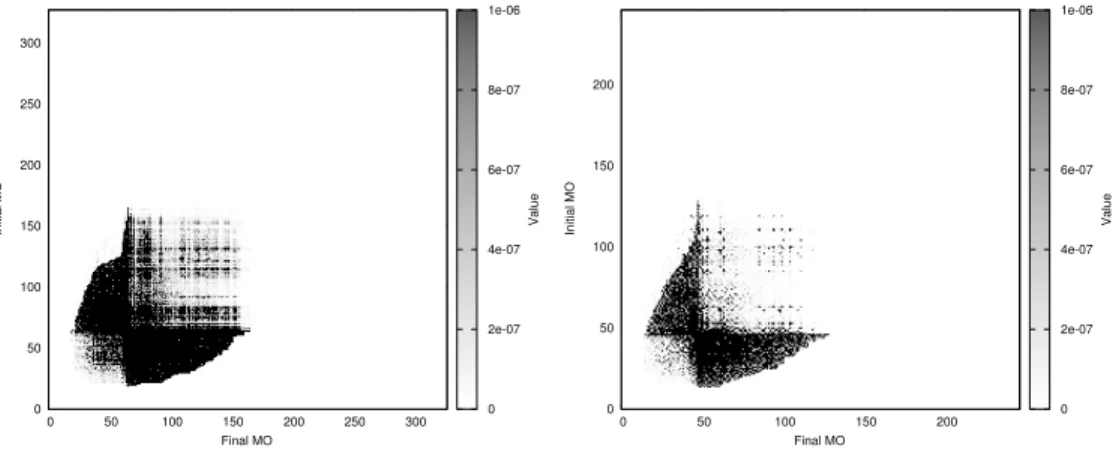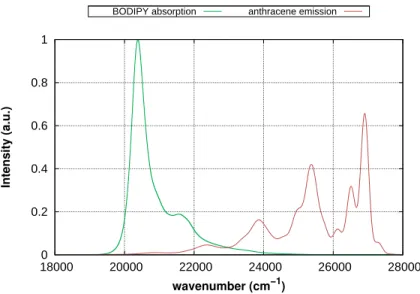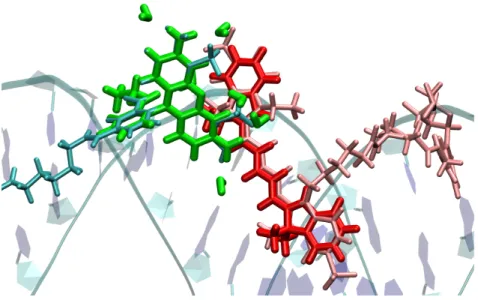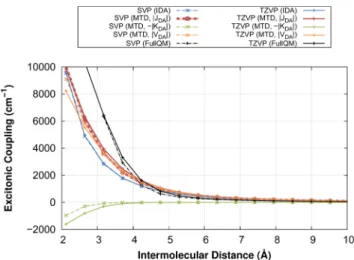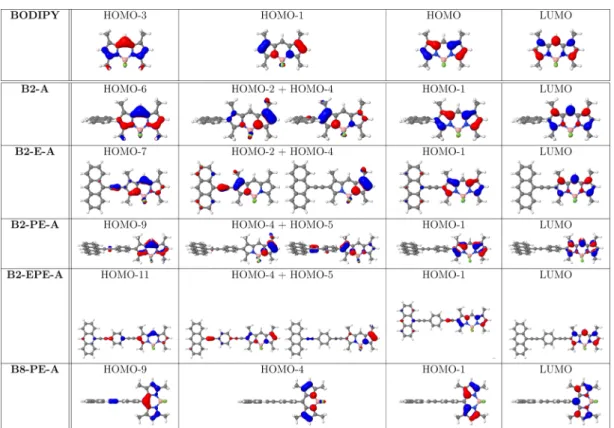and non-bridged bichromophoric systems
Inaugural-Dissertation
zur
Erlangung des Doktorgrades der
Mathematisch-Naturwissenschaftlichen Fakult¨at der Heinrich-Heine-Universit¨at D¨usseldorf
vorgelegt von Jan Dominik Spiegel
aus Neuss
D¨usseldorf, Oktober 2016
der Heinrich-Heine-Universit¨at D¨usseldorf
Gedruckt mit Genehmigung der
Mathematisch-Naturwissenschaftlichen Fakult¨at der Heinrich-Heine-Universit¨at D¨usseldorf
Referentin: Univ.-Prof. Dr. Christel M. Marian Korreferent: Univ.-Prof. Dr. Holger Gohlke Tag der m¨undlichen Pr¨ufung: 11. November 2016
Ich versichere an Eides statt, dass die Dissertation von mir selbst verfasst und ohne un- zul¨assige fremde Hilfe unter Beachtung der Grunds¨atze zur Sicherung der guten wis- senschaftlichen Praxis an der Heinrich-Heine-Universit¨at erstellt worden ist. Die aus fremden Quellen direkt oder indirekt ¨ubernommenen Gedanken sind als solche kenntlich gemacht. Die Dissertation wurde in der vorgelegten oder in ¨ahnlicher Form noch bei keiner anderen Pr¨ufungsbeh¨orde eingereicht. Es wurden keine fr¨uheren erfolglosen Pro- motionsversuche unternommen.
Neuss, den 28.09.2016
List of papers IX
Summary X
Zusammenfassung XI
1 Introduction 1
1.1 Excitons . . . 1
1.2 Excitation energy transfer . . . 2
1.3 Importance and applications . . . 4
1.3.1 Photosynthesis . . . 4
1.3.2 Organic photovoltaics . . . 5
1.3.3 Structure determination of biomolecules . . . 6
1.4 State of the art . . . 7
1.5 Motivation and objectives . . . 8
2 Theory 11 2.1 Photophysical processes and Franck-Condon principle . . . 11
2.1.1 Absorption . . . 12
2.1.2 Deactivation of electronically excited states . . . 14
2.2 EET rate . . . 15
2.2.1 Fermi’s Golden rule . . . 15
2.2.2 Franck-Condon weighted density of states . . . 19
2.2.3 Spectral overlap integral . . . 21
2.3 Density matrix theory . . . 22
2.3.1 Density function of an N-electron system . . . 22
2.3.2 Reduced density functions . . . 23
2.3.3 Expectation values of one- and two-electron operators . . . 24
2.3.4 Transition density functions . . . 26
2.3.5 From density functions to density matrices . . . 27 VII
VIII CONTENTS
2.3.6 Configuration interaction . . . 28
2.3.7 Second quantization . . . 29
2.3.8 Extension to group-function theory: Molecular dimers . . . 29
2.3.9 Analysis of the excited-state wave functions . . . 31
2.4 Excitonic coupling matrix element . . . 32
2.4.1 The two-state system . . . 32
2.4.2 Molecular heterodimer . . . 34
2.4.3 Davydov splitting: The molecular homodimer . . . 37
2.4.4 Ideal dipole approximation . . . 38
2.4.5 Monomer transition density approach . . . 43
2.4.6 Supermolecular transition density approach: Consideration of CT contributions . . . 44
2.5 F¨orster theory . . . 46
3 Implementations 51 4 Results and discussion 59 4.1 BODIPY/anthracene-based EET cassettes . . . 59
4.1.1 Direct contribution and the role of the molecular linker . . . 59
4.1.2 Charge transfer contributions . . . 60
4.2 Distance-dependent validity of IDA-based FRET model . . . 65
5 Outlook 69 5.1 Extension of the MTD method to triplet-triplet couplings . . . 69
5.2 Optimization of the STD code . . . 72
5.3 Enhancement of the sampling procedure . . . 73
5.4 Enhancement of the alignment procedure . . . 73
Literature 82
Acknowledgment 83
Included as part of this thesis:
1. Quantum chemical studies on excitation energy transfer in BODIPY-based donor- acceptor systems
J. Dominik Spiegel, Martin Kleinschmidt, Alexander Larbig, J¨org Tatchen, and Christel M. Marian, J. Chem. Theory Comput. 2015,11, 4316-4327
Own contribution: Implementation of the MTD and IDA approaches; parallelization of the MTD code; benchmark calculations; quantum chemical calculations; vibra- tionally resolved spectra; spectral overlap integral; ECMEs and the EET rates; ab initio MD simulations; first draft of manuscript
2. Charge-transfer contributions to the excitonic coupling matrix element in BODIPY- based energy transfer cassettes
J. Dominik Spiegel, Igor Lyskov, Martin Kleinschmidt, and Christel M. Marian, Chem. Phys. 2016,(submitted)
Own contribution: Derivation and implementation of the STD formalism; benchmark calculations; quantum chemical calculations; ECMEs; first draft of manuscript
3. Failure of the IDA in FRET systems at close inter-dye distances is moderated by frequent low κ2 values
J. Dominik Spiegel, Simone Fulle, Martin Kleinschmidt, Holger Gohlke, and Christel M. Marian, J. Phys. Chem. B 2016,120, 8845-8862
Own contribution: Implementation of the structure alignment algorithm; enhance- ment of the MTD method; quantum chemical calculations of Cy5; spectral overlap integral and vibrationally resolved spectra; ECMEs, orientation factors and EET rates; sampling and statistical analysis; first draft of manuscript
Not included as part of this thesis:
1. Singlet fission in quinoidal oligothiophenes
Nikolai Elfers, Igor Lyskov, J. Dominik Spiegel, and Christel M. Marian, J. Phys.
Chem. C 2016,120, 13901-13910
Own contribution: Creation of figures for the supplementary information
2. On the significance of the1La /1Lbnomenclature for fluoro-substituted indole derivates Josefin Wilke, Martin Wilke, Christian Brand, J. Dominik Spiegel, Christel M. Mar- ian, and Michael Schmitt, J. Phys. Chem. A,(to be published)
Own contribution: DFT/MRCI calculations
IX
Summary
Excitation energy transfer (EET) is an important photophysical process which describes the non-radiative transfer of electron-hole pairs between molecules. The process has vari- ous applications ranging from organic photovoltaics to methods for the structure determi- nation of biomolecules. Most quantum chemical approaches for the prediction of the EET rate are based on Fermi’s Golden rule. Here, the EET rate is proportional to the square of the excitonic coupling matrix element (ECME) between the appropriate electronic states.
In this work, the monomer transition density (MTD) approach for the computation of the ECME between two excited singlet states was implemented, adapted to the DFT/MRCI code and extended to exchange contributions. Furthermore, the method was refined by introducing a mechanism which ensures that only the orbitals are considered which refer to non-vanishing elements of the transition density matrices. To overcome the approxima- tion of treating the supermolecular EET system as two artificially isolated monomers and in order to consider charge-transfer (CT) contributions to the ECME, the MTD method was extended to the supermolecular transition density (STD). Both methods were applied to a number of EET cassettes in which BODIPY serves as exciton acceptor and is linked to anthracene by a molecular bridge. Using the MTD approach and in presence of the linker, the experimental EET rates in the range of picoseconds could fairly be reproduced.
In absence of the bridge, MTD and STD provide similar results while the MTD seems to overestimate the ECME in presence of the linker due to the neglect of the CT contri- butions. It could be shown that the experimentally observed highly efficient EET in a cassette with perpendicular donor acceptor transition dipole moment orientation can be traced back to dynamic effects. To study the validity of the F¨orster EET model at small donor acceptor distances in a realistic system, a method was developed making a large number of snapshots, obtained from molecular dynamics (MD) simulations, accessible to a transition density-based method for the computation of the ECME. By the use of a quaternion-based approach preoptimized structures of the two subsystems were aligned to the MD snapshots such that a costly relaxation of the structures and recomputation of the transition density matrices is avoided. The method was applied to a pair of dyes attached to a double-stranded RNA. Due to certain preferred relative arrangements of the dyes, substantial deviations from an isotropic transition dipole moment distribution and a Gaussian distance vector distribution could be found. However, the EET rates remain unaffected because the periods in which the failure of the ideal dipole approximation (IDA) is large, have a minor statistical weight.
X
Exzitonischer Energietransfer (EET) ist ein bedeutender photophysikalischer Prozess, der den strahlungslosen Transfer von Elektronen-Loch-Paaren zwischen Molek¨ulen beschreibt.
Anwendungen reichen von der organischen Photovoltaik bis hin zur Strukturaufkl¨arung von Biomolek¨ulen. Die meisten quantenchemischen Methoden zur Berechnung der EET- Rate basieren auf Fermis Goldener Regel. Dabei ist die EET-Rate proportional zum Quadrat des exzitonischen Kopplungsmatrixelements (ECME). In der vorliegenden Ar- beit wurde die MTD-Methode zur Berechnung des ECME auf die DFT/MRCI Methode angepasst und um einen Austauschterm erweitert. Durch einen neuen Mechanismus, wer- den nur solche Orbitale ber¨ucksichtigt, die sich auf nicht verschwindend kleine Elemente der ¨Ubergangsdichtematrizen beziehen. Um Charge-Transfer (CT) Beitr¨age ber¨ucksich- tigen zu k¨onnen und die Subsysteme nicht isoliert betrachten zu m¨ussen, wurde eine zum MTD Ansatz analoge Methode entwickelt, die auf den ¨Ubergangsdichten des Super- molek¨uls basiert. Beide Methoden wurden auf eine Reihe von EET-Kassetten angewen- detet, in denen ein Anthracen-Donor ¨uber eine molekulare Br¨ucke mit einem BODIPY- Akzeptor verbunden ist. Unter Anwendung des MTD Ansatzes und Ber¨ucksichtigung der Br¨ucke konnten die experimentellen EET-Raten in der Gr¨oßenordnung von Picosekun- den reproduziert werden. In Abwesenheit der Br¨ucke liefern MTD und STD ¨ahnliche Ergebnisse, w¨ahrend MTD aufgrund der Vernachl¨assigung der CT Beitr¨age das ECME in Anwesenheit der Br¨ucke ¨ubersch¨atzt. Weiterhin konnte gezeigt werden, dass der effiziente EET in einer der Kassetten, in der die ¨Ubergangsdipolmomente von Donor und Akzep- tor rechtwinklig angeordnet sind, auf dynamische Effekte zur¨uckzuf¨uhren ist. Um die Richtigkeit des EET-Modells von F¨orster in einem realistischen System zu untersuchen, wurde eine Methode entwickelt, mit der eine große Anzahl von Schnappsch¨ussen aus einer Molekulardynamiksimulation (MD) einer ¨Ubergangsdichte-basierten Methode zur Berech- nung des ECME zug¨anglich gemacht werden kann. Durch die Anpassung voroptimierter Strukturen der Farbstoffe an die Strukturen der MD Schnappsch¨usse kann eine aufwendige Relaxierung der Strukturen und somit eine erneute Berechung der ¨Ubergangsdichtematri- zen vermieden werden. Die Methode wurde auf ein Farbstoffpaar angewendet, wobei die beiden Farbstoffe jeweils kovalent an eine doppelstr¨angige RNA gebunden waren.
Aufgrund bestimmter, bevorzugter relativer Anordnungen der Farbstoffe konnten Ab- weichungen von einer perfekten Gauß-f¨ormigen Abstandsverteilung und von einer per- fekten isotropischen Verteilung des ¨Ubergangsdipolmoments gefunden werden. Trotzdem bleibt die EET-Rate nahezu unver¨andert, da die Zeitr¨aume, in denen der Fehler der idealen Dipoln¨aherung (IDA) groß ist, einen geringen statistischen Einfluss haben.
XI
Chapter 1
Introduction
1.1 Excitons
-
+
-
+ B A
Figure 1.1: Schematic illustration of Frenkel (A) and Wannier-Mott (B) excitons in a lattice.
An exciton is a quasi-particle defined as a coupled electron-hole pair. The term has its origin in solid-state physics. The process of excitation energy transfer, which is treated in this work, refers to the migration of such electron-hole pairs within a molecular aggregate, a polymer or a molecular dimer and is not restricted to the solid state. However, to get an insight into the formation and behavior of electron-hole pairs, a basic understanding of the chemical composition of solids is required.
In a solid, atoms are periodically arranged on a 3-dimensional lattice. Solids characterized by a long-range order of this lattice are called crystals. The electronic structure of crys- talline solids can be described by the band model. [1] In the case of only two interacting atoms, atomic orbitals (AOs) of the same kind (1s, 2s, 2p, ...) split into pairs of binding and anti-binding molecular orbitals (MOs). Adding more and more atoms, the number of resulting MOs increases while the energetic distance becomes smaller and smaller, fi- nally resulting in a band structure. The highest occupied energy band is called valence
1
band while the lowest unoccupied energy band is called conduction band. As long as a band is not fully occupied, the electrons are fully delocalized such that the charge-carriers can move freely from atom to atom within the lattice. Excitation of an electron from the valence band to the conduction band leads to a coupled electron-hole pair — a so- called exciton. Due to the band structure, the electron-hole-pair can move freely within the three-dimensional lattice. The binding energy between the electron in the conduction band and the hole in the valence band depends on their distance according to which exci- tons can be classified (Fig. 1.1). In honor of the Russian physicist Jakow Iljitsch Frenkel, local, tightly-bound excitons are calledFrenkel excitons. [2] They are characterized by small electron-hole separations in the range of 1 nm and high binding energies of up to 1 eV. [3] In contrast, excitons with a substanially larger electron-hole distance and smaller binding energy, respectively, are named after the Swiss and English physicists Gregory Hugh Wannier and Nevill Francis Mott (Wannier-Mott excitons). [4] In the special case in which the electron and the hole are located on adjacent molecules of the lattice, the exciton is called charge-transfer (CT) exciton and can be regarded as an intermediate state between a Frenkel and a Wannier-Mott exciton. [5]
In the case of single organic molecules instead of crystalline solids, the situation is more straightforward since a band structure does not exist. Therefore, each electronically ex- cited state can be regarded as an exciton. [6] An excitation which is perfectly localized on one molecule is treated as Frenkel exciton while a charge transfer excitation between two molecules is regarded as Wannier-Mott exciton. In larger multichromophoric ensem- bles and periodic polymeric structures the situation is similar to the one in crystalline solids. Here, the monomer units of the polymer play a role comparable to the atoms within the lattice of a solid. The interaction between two excitons is called excitonic cou- pling (EC). Restricting our considerations to the interaction between single molecules in bichromophoric systems and small ensembles of chromophores, the EC is equivalent to the interaction between two electronically excited states.
1.2 Excitation energy transfer
VDA
A A*
D D*
Figure 1.2: EET can in the simplest case be understood as simultaneous excitation of the acceptor and a deexcitation of the donor.
1.2. EXCITATION ENERGY TRANSFER 3
Förster LUMO
HOMO
Dexter LUMO
HOMO
Donor Acceptor
Figure 1.3: Illustration of the F¨orster and the Dexter EET mechanisms in a HOMO- LUMO-model.
Excitation energy transfer (EET) is a photophysical process which describes the non- radiative transfer of an exciton between two molecular systems. These systems can either be individual molecules, monomeric units of a di- or polymeric structure or elements of a large molecular ensemble. EET was first described by Theodor F¨orster in the 1940s considering two individual chromophores which can be independently photoexcited. [7, 8]
F¨orster described the process as a simultaneous excitation and deexcitation process of the acceptor and the donor, respectively, without emission and reabsorption of a photon (Fig. 1.2). In a four-electron-four-orbital model the F¨orster mechanism can be explained as a local transition of an electron from the highest occupied molecular orbital (HOMO) to the lowest unoccupied molecular orbital (LUMO) in the acceptor which is coupled to the appropriate opposite transition in the exciton donor (Fig. 1.3). It is important to mention that both transitions are strongly localized on the individual molecules and that no exchange of charge carriers takes place. According to the F¨orster mechanism EET can only take place if both transitions are allowed. Strictly speaking, this is only the case if both excited states have the same multiplicity as the appropriate electronic ground state. However, formally spin-forbidden processes can become allowed in the case of strong spin-orbit coupling. Therefore, EET can take place, according to the F¨orster mechanism, between a triplet and a singlet state if the donor phosphorescence is strong.
Nevertheless, the term F¨orster resonance energy transfer (FRET) usually describes the transfer of excitation energy between two excited singlet states. Since the vehicle of the coupling between the two transitions is the dipole-dipole interaction which decreases with r−3, the donor acceptor separation can reach values in the range of 30-80 ˚A and higher. [9]
In the 1960s, David L. Dexter developed a mechanism describing EET at short donor acceptor distances requiring an overlap of the MOs. [10] In contrast to F¨orster, Dexter described the EET processes as simultaneous migration of an electron from the donor to
the acceptor and of another electron from the acceptor back to the donor (Fig. 1.3). The Dexter exchange mechanism is able to describe triplet-triplet energy transfer for which the F¨orster term is vanishing, and explains additional contributions in the case of short- range singlet-singlet EET where the spatial overlap of the MOs of interacting molecules is not negligible. To achieve a high EET efficiency EEET, the EET ratekEET has to be significantly larger than the rates of the competing processes [11]
EEET = kEET
kEET +kf l+knr (1.1)
where kf l and knr are the donor fluorescence rate and non-radiative decay rate, respec- tively. Typical EET rates are found in the range of picoseconds. It is important to mention that EET always denotes the formal transfer of an electron-hole pair between two molecules. The migration of single electrons is described by the Marcus theory [12]
and will not be discussed in this work.
1.3 Importance and applications
EET is an important photophysical process which is exploited for numerous technical and scientific applications based on optoelectronics. In nature, it was originally found as a key step of photosynthesis which takes place in the light-harvesting complexes (LHC) of plants. [13] In an attempt to imitate this highly efficient process of energy conversion, solar cells have been developed. [14] Furthermore, EET is exploited in biophysical chemistry for the investigation of the molecular structure and the dynamics of biomolecular systems. [15, 16] In the following, an overview of the most important applications of EET will be given.
1.3.1 Photosynthesis
Phototropic organisms such as plants, algae and some bacteria are able to convert electro- magnetic radiation into a chemical potential. [17] During photosynthesis in plants, single chlorophyll molecules located in the LHCs in the chloroplasts are photoexited. To cover a large part of the visible spectrum, the LHCs not only contain chlorophyll-a but also chlorophyll-b and various carotenoids. The created excitons are transferred between adja- cent chlorophyll molecules towards the reaction centers where the charge separation takes place by various redox reactions in photosystem I and II creating a H+ gradient between stroma and lumen of the cell. The gradient is exploited to drive the biosynthesis of ATP which is the universal energy carrier of living organisms.
1.3. IMPORTANCE AND APPLICATIONS 5
hv +/-
+/-
+/-
+ -
e- e-
HTL ETL
A
B
C
D
Figure 1.4: Schematic design and working principle of an organic solar cell. A: Photon absorption, B: Exciton migration, C: Charge separation, D: Charge carrier migration.
HTL: hole transport layer (reception layer), ETL: electron transport layer.
1.3.2 Organic photovoltaics
In organic photovoltaics, inorganic semiconductors such as silicium dioxide or titanium dioxide are replaced by cheaper organic compounds. [18] The working principle is closely related to the process of photosynthesis in nature. An organic solar cell is generally composed of two electrodes, a reception layer (also termed hole transport layer, HTL) and an electron transport layer (ETL) (Fig 1.4). [14, 19] One electrode is composed of indium tin oxide or another transparent electronically conductive material such that sun light can reach the excitation layer. Both, excitation layer and ETL, consist of different polymeric materials which are arranged in a way maximizing the interface area. The process of energy conversion can be separated into four major steps (Fig. 1.4). In the first step, a photon is absorbed by a monomer unit of the polymeric excitation layer material. During absorption, the monomer unit is photoexcited and passes over to an electronically excited state representing an exciton. In a second step, the exciton migrates from monomer unit to monomer unit via EET towards the intersection area between excitation and electron transport layer. To achieve a high efficiency of the solar cell, the process of exciton migration has to be much faster than the competing processes such as spontaneous fluorescence or recombination of the electron and the hole. At the intersection between the two layers the exciton is separated into two free charge carriers. In a last step,
hole and electron migrate from monomer unit towards the electrodes creating a voltage which can be used to run an electrical consumer. Hole and electron recombine via the circuit, resetting the system to the initial state.
1.3.3 Structure determination of biomolecules
hvin hvout
hvin hvout FRET
Figure 1.5: Example of FRET used for the detection of the structural change of a protein upon substrate binding.
In biophysical chemistry, the phenomenon of EET is used for the investigation of the structure and the dynamics of biomolecules such as enzymes and nucleic acids. [15] In the most straightforward scenario, a suitable pair of fluorescent dyes is covalently bound to different sites of the target molecule (Fig. 1.5). [20] Since EET takes place between the fluorescent singlet states of the dyes in this context, the term FRET is used in particular, where the ”F” refers to the F¨orster theory. The dyes and linkers are chosen in a way ensuring that the structure and activity of the enzyme remain largely unaffected. Changes of the molecular structure of the target molecule induced by the binding of a substrate or a biochemical reaction can be monitored via changes of the EET rate due to the altered distances between donor and acceptor. When photoexciting the donor, almost exclusively donor fluorescene will be detected when the dyes are well separated. Due to a decreased donor acceptor distance induced by a structural change of the target system, EET becomes more efficient. In this case, acceptor fluorescence can be detected as well upon photoexcitation of the donor. Over the last four decades, highly demanding setups have been developed allowing, e.g., the real-time monitoring of biochemical reactions in vivo and in vitro. [16, 20]
1.4. STATE OF THE ART 7
1.4 State of the art
Experimentally, EET rates can be determined by ultra-fast laser spectroscopy in the pi- cosecond or femtosecond regime. [21, 22] One possibility to access EET rates in quantum chemistry is the application of Fermi’s Golden rule. In this context, the EET rate is propor- tional to the square of the ECME between the interacting electronically excited states. [6]
It is important to underline that a high ECME is a necessary but not a sufficient condition for an efficient EET as the pairs of donor deexcitation and acceptor excitation have to be energy-conserving. Alternatively, EET rates can be obtained by excited state molecular dynamics (MD) simulations which is beyond the scope of this work. From a quantum chemical point of view, the challenge is to find an efficient way to accurately compute the EC for molecular systems in which donor and acceptor are not identical. Otherwise the total coupling can directly be calculated from half of the energy splitting (Davydov split- ting) between the interacting states as will be shown later. [23] Methods for computing the EC can be separated into monomeric and supermolecular approaches.
In monomeric approaches both subsystems are calculated separately. The wave function of the supermolecular system is approximated as the product of the wave functions of the two individual subsystems. The simplest monomeric approach is directly based on the F¨orster theory, calculating the EC as a distance-dependent interaction of two transi- tion dipole moments. [6, 7, 8] More accurate results can be achieved if the full transition densities are used instead. In the transition density cube (TDC) method, the transition densities are numerically integrated using a three-dimensional grid. [24] Another way is provided by the distributed transition monopole (DTM) approach approximating the tran- sition densities as a set of point charges located on the two subsystems between which the interaction takes place. [25] The monomer transition density (MTD) approach constitutes a further development of the TDC method expanding the transition densities within the MO basis. [26, 27] The MTD approach is the major approximation used within this work and will be treated in detail later on. Furthermore, Mennucci and coworkers developed a monomeric approach including solvation effects represented by a continuum model. [28, 29]
In the 1990s, Harcourt et al. presented a minimal four-electron-four-orbital model provid- ing the opportunity of a separate consideration of local, exchange and CT contributions to the EC in a homodimer. [30, 31, 32] Russo et al. generalized the model to an arbitrary number of orbitals. [33] A method for the consideration of CT contributions which is not restricted to homodimers was developed by Fujimoto. [34, 35] Introducing two ionic in- termediate states the EET process can take place according to four different pathways.
While the direct part of the EC between the pure locally excited initial and the pure
locally excited final states is calculated in analogy to the MTD method, CT excitations are approximated in a HOMO-LUMO-based approach. Additionally, Fujimoto considers the presence of the respective other monomer by using a frozen-density-embedding formal- ism. A similar approach based on subsystem-density functional theory (DFT) has been presented by Neugebauer et al. [36, 37] A method which aims for the approximation of the influence of the molecular linker between the donor and the acceptor subsystems was introduced by Caprasecca and Mennucci. [38]
In contrast to monomer based methods, the electronic wave function of the total system is used for further analysis in all supermolecular-based approaches. The simplest approach of this kind is the use of the Davydov splitting for the calculation of the EC which is only possible in the case of a homodimer. [23] Although the calculated EC is exact with respect to the accuracy of the quantum chemical method, its separation into the indi- vidual contributions is not straightforward. In supermolecular-based methods suitable for the treatment of molecular heterodimers, diabatization techniques are applied. The calculation is performed by finding the correct unitary transformation which converts the diagonal adiabatic Hamiltonian into the non-diagonal Hamiltonian of the interacting dia- batic states. In this case, the EC is equivalent to the off-diagonal elements of the diabatic Hamiltonian. Exploiting a phyical quantity which is known for both, the excited states of the isolated monomers and for the corresponding excited states of the supermolecular system, a unitary transformation can be deduced. In a second step this unitary trans- formation is used for the transformation of the adiabatic Hamiltonian. By this means, the fragment excitation difference (FED) and the fragment spin difference (FSD) methods developed by Hsu et al. enable the calculation of the EC between two singlet and two triplet states, respectively. [39, 40, 41, 42] In 2014, Blancafort and Voityuk developed a similar model using a quantity for the exciton delocalization within the supermolecular arrangement introduced by Lischka and coworkers [43] to find the correct unitary trans- formation. [44] In order to account for additional CT contributions, the formalism has been extented to a three-state model. Irrespective of the higher computational cost in comparison to monomer based calculations, supermolecule approaches often provide less accurate results. [45] The problem is that the adiabatic states are not solely composed of energetically lowest local transitions but comprise significant additional contributions of higher diabatic states.
1.5 Motivation and objectives
EET is an important photophysical process with numerous applications in chemistry and physics. A detailed understanding of the process is the basis of technological advance in the field of optoelectronics. Research particularly aims for the development of new chemical compounds enhancing the still low efficiency of organic solar cells. Theoretical
1.5. MOTIVATION AND OBJECTIVES 9 calculations can make a decisive contribution predicting the EC and EET rates. By this means, the expensive and demanding synthesis of new compounds can be concentrated on theoretically promising candidates. By the study of model systems, the detailed coupling mechanism, the importance of the molecular geometries and certain substitutes as well as the influence of the architecture of the molecular linker can be understood. A detailed understanding of the processes in model systems provides a valuable basis for the devel- opment of new materials.
The primary objective of this work was the implementation of a transition density-based method for the calculation of the EC between two excited singlet states in bichromophoric systems which is adapted to the DFT/MRCI code [46]. The program was devised for the investigation of a number of EET cassettes focussing on the influence of the molecular linker between the donor and the acceptor subsystems. Furthermore, an efficient method connecting to molecular dynamics (MD) simulations was to be provided to be able to study also the dynamics of EET. The method was applied to a well-known FRET model system investigating the validity of the IDA-based F¨orster theory in the case of very small donor acceptor distances.
The use of monomer-based approaches implies the necessity of splitting the considered supermolecular donor-acceptor system into two isolated subsystems. In the case of a molecular bridge between the donor and the acceptor moiety, a covalent bond has to be split and the resulting fragments have to be saturated with hydrogen atoms. Both, the artificial treatment of the donor and the acceptor as isolated systems and the modification of the chemical structure only allow an approximate study of the original system. To over- come this problem, the initial objective was to use the fragment molecular orbital (FMO) method [47, 48] as implemented in the GAMESS US suite of programs [49] to split the supermolecule into donor and acceptor subsystems. The method was originally developed for the description of large molecules in the electronic ground state and provides excellent results for polypeptides and proteins. [50] In the FMO method, the target system is split into fragments whose energies are determined variationally considering the electrostatic interaction between the fragments by an iterative computation scheme fully relaxing the fragment electron densities. The energy of the unperturbed system can directly be cal- culated from the sum of the energies of the fragments. In a second step, the interaction energies between each pair of fragments is calculated and added as perturbational correc- tion. Therefore, the electronic ground state energy of the total system (E) is obtained from the appropriate energies of the individual fragments (Ei) and fragment pairs (Eij).
E=X
i
Ei+X
i>j
(Eij−Ei−Ej) (1.2)
Due to the dimer correction (second term in Eq. 1.2) the methods is not fully varia- tional. [50] In the FMO method, covalent bonds are split heterolytically. A capping of the resulting fragments is performed effectively by adding the Coulomb field of all other fragments to the considered fragment. Therefore, a saturation with hydrogen atoms is not necessary. An extension of the method to the multi-configuration self-consistent field (MC- SCF) approach enables the description of electronically excited states. [51] To calculate the EC in molecular dimers, the FMO method was planned to be used to compute a set of perfectly donor and acceptor localized MOs. These orbitals were intended for the calcula- tion of the one- and two-electron integrals required by the DFT/MRCI method providing the transition densities. However, it showed that the FMO method in its present form is incompatible with the DFT/MRCI approach. The orbitals obtained by the FMO method are not canonical (diagonal Fock matrix) which is explicitly required in DFT/MRCI. Fur- thermore, the systems to be studied are characterized by molecular linkers leading to a delocalization of the MOs beyond the borders of the donor and acceptor moieties. The FMO fragmentation principle refers to the splitting of single bonds preserving the elec- tron density within each fragment as most as possible. Therefore it particularly cannot be applied to π-conjugated systems.
Chapter 2
Theory
This section is particularly based on refs. [6, 52, 53].
2.1 Photophysical processes and Franck-Condon principle
S0
S2
S1
T1 S1
S0
T1
Acceptor Donor
P ISC
A F
TT-EET SS-EET
IC
A
F P
ISC
Figure 2.1: Jablonski diagram schematically illustrating the most important photophysical processes. A: absorption, F: fluorescence, P: phosphorescence, IC: internal conversion, ISC: intersystem crossing, SS-EET: singlet-singlet excitation energy transfer, TT-EET:
triplet-triplet excitation energy transfer. Dashed arrows denote non-radiative relaxation processes.
11
v = 0 v = 1
v = 2 v = 3
v = 4
R
eqv = 0 v = 1
v = 2 v = 3
v = 4
absorption
fluorescence
E
S
0S
1Figure 2.2: Absorption and fluorescence according to the Franck-Condon approximation using the harmonic approximation.
2.1.1 Absorption
The term absorption refers to the excitation of a molecular system due to interaction with resonant electromagnetic radiation. While low energetic radiation in the microwave and infrared (IR) region gives rise to molecular vibrations and rotations, respectively, reso- nant radiation in the visible (Vis) and the ultraviolet (UV) region (14000−50000 cm−1) causes a reorganization of the electron density within the molecule. In the electronically excited state, which usually has the same spin-multiplicity as the electronic ground state, the electron density as well as the positions of the nuclei in space has changed compared to the electronic ground state. The Franck-Condon principle [54, 55, 56] states that the reorganization of the nuclei takes place on a slower time-scale than the electronic transi- tion due to the much higher mass of the nuclei compared to the electrons. Therefore, each electronic state can be regared as being composed of a number of vibrational substates, where the combination of an electronic and a certain vibrational substate is called vibronic state (Fig. 2.2). A vibronic transition refers to a transition between a certain vibrational substate of a certain electronic state and a certain vibrational substate of a different elec- tronic state. The difference between the equilibrium molecular geometries of the electronic ground state and the electronically excited state is described by the coordinate ∆Req. Ac- cording to the thermal occupation of the vibrational substates of the electronic ground state, an excitation takes place vertically leading to the occupation of different vibrational
2.1. PHOTOPHYSICAL PROCESSES AND FRANCK-CONDON PRINCIPLE 13 substates of a certain electronically excited state which depends on the excitation energy.
The vibrational progression of the absorption spectrum can be explained by the different probabilities of these vibronic transitions which depend on the overlap of the vibrational wave functions. The intensity of a vibronic transition is proportional to the absolute square of the transition dipole moment|µf i|2 between the initial Ψi and the final vibronic states Ψf which are defined as the product of the appropriate electronic and vibrational wave functions. [1]
|Ψi(~r1, ~r2, ..., ~rN, ~R1, ~R2, ..., ~RM)i= |ψi(~r1, ~r2, ..., ~rN, ~R1, ~R2, ..., ~RM)i (2.1)
× |χi(R~1, ~R2, ..., ~RM)i
hΨf(~r1, ~r2, ..., ~rN, ~R1, ~R2, ..., ~RM)|= hψf(~r1, ~r2, ..., ~rN, ~R1, ~R2, ..., ~RM)| (2.2)
× hχf(R~1, ~R2, ..., ~RM)| In atomic units, the molecular dipole operator is given by
µ=−
N
X
i=1
~ri
| {z }
µel
+
M
X
j=1
ZjR~j
| {z }
µnuc
(2.3)
where ri and Rj are the cartesian coordinates of the i-th electron and the j-th nucleus, respectively, and where Zj is the atomic number of the j-th nucleus. The absolute square of the expectation value of the transition dipole moment between the initial and the finial vibronic states reads
|µf i|2 = | hΨf|µ|Ψii |2 (2.4)
= | hΨf|µel|Ψii+hΨf|µnuc|Ψii |2 (2.5)
= | hψfχf|µel|ψiχii+hψfχf|µnuc|ψiχii |2 (2.6) Applying the Condon approximation Eq. 2.6 can further be decomposed to
|µf i|2 = hχf|χii hψf|µel|ψii |R=Req +hψf|ψii |R=Req
| {z }
=0
hχf|µnuc|χii2 (2.7)
Due to the orthogonality of the electronic states, the term which depends on the nuclear coordinates vanishes such that the the expression becomes
|µf i|2 = | hχf|χii hψf|µel|ψii |2 (2.8)
= | hχf|χii |2· | hψf|µel|ψii |2 (2.9)
where the absolute square of the overlap integral between the vibrational wave functions is defined as so-calledFranck-Condon factorwhich is a measure for the probability of the appropriate vibronic transition. The Franck-Condon principle not only holds true in the framework of absorption but can also be applied to emission as long as the reorganization of the nuclei is slower than the reorganization of the electrons.
2.1.2 Deactivation of electronically excited states
Due to the higher energy of the electronically excited state compared to the electronic ground state, the system returns to the electronic ground state as fast as possible. Due to the existence of different radiating and non-radiating photophysical processes, more than only one pathway is possible for deactivation. [1] Which processes actually take place in a certain molecular system depends on the appropriate rate constants. According to the Franck-Condon principle, the excitation takes place vertically from thermally occupied substates of the electronic ground state populating different vibrational substates of the electronically excited state with a different probability. In solution or in the solid state where the excited molecule can exchange energy with the surrounding molecules, the system relaxes to the vibrational ground state of the current electronically excited state by vibrational relaxation. During this process, parts of the excitation energy are converted to thermal energy due to molecular vibrations and due to collisions with solvent molecules.
From the vibrational ground state, the system can undergo a transition to an isoenergetic vibrational substate of a different electronic state of either the same spin multiplicity (typically singlet to singlet or triplet to triplet transitions) or a different spin multiplicity (transitions between singlet and triplet states). Such transitions between two states of the same spin multiplicity are calledinternal conversion (IC)while transitions between two states of different spin multiplicity requiring a spin flip are calledintersystem crossing (ISC). While IC is spin-allowed, ISC is a spin-forbidden process which only takes place in molecular systems with high spin–orbit coupling (SOC) causing a mixture of singlet and triplet states. SOC is important in all compounds which comprise at least one heavy atom such as sulfur or a transition metal. Furthermore, a radiative deactivation can theoretically take place vertically from the lowest vibrational level of each electronically excited state by either fluorescence or phosphorescence, respectively. The resulting emission spectrum has a vibrational progression which corresponds to Franck-Condon factors between the different vibronic states. Since IC and ISC usually are faster than fluorescence and phosphorescence, respectively, Kasha’s rule states that fluorescence and phosphorescence always takes place from the lowest excited state of a given multiplicity (S1 and T1). [57] This rule is true for most but not for all molecular systems. Since phosphorescence is a spin-forbidden process, it usually occurs on a much slower time scale
2.2. EET RATE 15 than fluorescence. Similar to ISC, phosphorescence is only possible in molecules with non-zero SOC. If a second, suitable molecule is located next to an electronically excited state, the excitation energy may also be transferred to the second molecule. A detailed quantum chemical description of this non-radiating process known as excitation energy transfer (EET) is the main scope of this work and will be treated in detail. EET can take place between electronic states with the same (singlet to singlet, or triplet to triplet) or a different spin-multiplicity (singlet to triplet, or triplet to singlet). In this work, we restrict our considerations to the EET between two excited singlet states. Excitation of a molecule may also induce a photochemical reaction which is beyond the scope of this work.
Typical time scales of the most important photophysical processes are listed in Tab. 2.1.
Photophysical Process Lifetime Rate (s−1)
absorption fs 10−15
internal conversion ps 10−14 - 10−11 internal conversion (to GS) ns - µs 10−9 - 10−7 intersystem crossing ns 10−11 - 10−8
fluorescence ns - µs 10−11 - 10−6
phosphorescence ms - s 10−3 - 10+2 excitation energy transfer ps - ns
Table 2.1: Typical time scales of photophysical processes. [11] GS: electronic ground state.
2.2 EET rate
2.2.1 Fermi’s Golden rule
Under specific conditions which will become clear in the course of this section, the EET rate can be calculated using Fermi’s Golden rule. [52] The formula derived by Enrico Fermi and Paul Dirac [58, 59] generally provides a rate constant for the transition from a certain energy eigenstate into a continuum of eigenstates and is based on a perturbational treatment of the HamiltonianHof the target system. [6, 60, 61] In the framework of EET, the non-perturbed Hamiltonian H0 represents the non-interacting donor and acceptor molecules. To obtain the Hamiltonian Hof the interacting chromophores, the interaction V(t) is introduced as a time-dependent perturbation of the non-interacting system.
H=H0+V(t) (2.10)
The time-independent Schr¨odinger equation of the non-interacting system reads
H0|φni=En|φni (2.11)
where φn are the eigenstates of H0 with eigenenergies En. The eigenstates |ψn(t)i of the corresponding time-dependent Schr¨odinger equation of the non-interacting system are composed of a time-independent term which is equivalent to the eigenstates of H0 and a time-dependent term represented by an imaginary exponential function.
|ψn(t)i=|φnie−iEnt~ (2.12)
The solutions|Ψ(t)iof the time-dependent Schr¨odinger equation of the interacting system H
H |Ψ(t)i= (H0+V(t))|Ψ(t)i=i~d
dt|Ψ(t)i (2.13) are assumed to be linear combinations of the eigenstates |ψn(t)i of the non-interacting systemH0.
|Ψ(t)i = X
n
cn(t)|ψn(t)i (2.14)
= X
n
cn(t)|φn(t)ie−iEnt~ (2.15) Substituting Eq. 2.15 into Eq. 2.13, one obtains
H0X
n
cn(t)|φnie−iEnt~ +V(t)X
n
cn(t)|φnie−iEnt~ = d dti~X
n
cn(t)|φnie−iEnt~ (2.16) Using Eq. 2.11 the expression simplifies to
X
n
cn(t)En|φnie−iEnt~ +V(t)X
n
cn(t)|φnie−iEnt~ = d dti~X
n
cn(t)|φnie−iEnt~ (2.17) Applying the product rule to derive the right hand side of the equation, we obtain
X
n
cn(t)En|φnie−iEnt~ + V(t)X
n
cn(t)|φnie−iEnt~ (2.18)
= i~ X
n
d
dtcn(t)|φni
e−iEnt~ +X
n
cn(t)En|φnie−iEnt~ Multiplying withhφk|, the expression reads
X
n
cn(t)hφk|V(t)|φnie−iEnt~ =i~ X
n
d
dtcn(t)hφk|φni
e−iEnt~ (2.19) Introducing the perturbation matrix element Vkn
Vkn(t) =hφk|V(t)|φni (2.20)
2.2. EET RATE 17 and using the orthogonality of the eigenstates φk and φn (hφk|φni=δkn), one obtains
X
n
cn(t)Vkn(t)e−iEnt~ =i~
d
dtck(t)e
−iEkt
~ (2.21)
Rearranging the expression and defining the energy difference between the eigenstates φk and φn as
ωkn= Ek−En
~ (2.22)
leads to
d
dtck(t) = 1 i~
X
n
cn(t)Vkn(t)eiωknt (2.23) The differential equation can be solved approximately by a perturbation expansion which is truncated after the first-order term. Here, the solution of order (p+1) is obtained iteratively from the solution of orderp. [61]
d
dtc(p+1)k (t)≈ 1 i~
X
n
c(p)n (t)Vkn(t)eiωknt (2.24) Suppose that for t= 0 the system is in the initial state |ii such that
c(0)k (t= 0) =δki
1 for k=i
0 for k6=i (2.25)
which is the zeroth-order solution of Eq. 2.23 since all expansion coefficients ck remain constant in time in absence of a perturbation. The first-order solution describes the situation in which the perturbation is switched on and is obtained by substituting the zeroth-order solution (Eq. 2.25) into Eq. 2.23 and solving the resulting differential equation.
d
dtc(1)k (t) = 1
i~Vki·eiωkit (2.26)
Since the perturbation is supposed to describe the electrostatic interaction between two excitons, it can be assumed to be time-independent
Vki(t) =Vki=const. (2.27)
Therefore, the differential equation can simply be solved by integration of the exponential function such that the first-order solution yields
c(1)k (t) = 1 i~Vki
Z t 0
eiωkitdt (2.28)
= 1
i~Vkieiωkit−1 iωki
(2.29)
Truncating the perturbation expansion after the first-order term, it follows that ck(t)≈ δki
|{z}
c(0)k
+ 1 i~Vki
eiωkit−1 iωki
| {z }
c(1)k
(2.30)
The probability of finding the system in state|kidifferent from the initial state|iiat time tis given by
Pki(t) =|ck(t)|2 = 1
~2
|Vki|2ei(ωki)t−1 iωki
2 (2.31)
= 1
~2
|Vki|2ei(ωki)2t ·ei(ωki)2t −e−i(ωki)2t iωki
2 (2.32)
= 1
~2|Vki|2ei(ωki)2t ·2 sin(ωkit 2) ωki
2 (2.33)
= 4
~2
|Vki|2sin2(ωki2t)
ω2ki (2.34)
The average rate is given by the transition probability per time Pki(t)
t = 4
~2
|Vki|2·sin2(ωki2t) t·ω2ki
| {z }
f(t,ωki)
(2.35)
Finding the system in the final statekafter a long time (t→ ∞) forces energy conservation due to the strong peaking of f(t, ωki) at ωki ≈0.
t→∞lim f(t, ωki) = π
2δ(ωki) (2.36)
Defining dnas the number of states in the energy interval dωki, the density of statesnear Ek is
ρ(Ek) = dn
dEk (2.37)
2.2. EET RATE 19 Therefore, the total transition rate kki only refers to final states k0 near state k with an energy close to Ek.
kki = 1 t
X
k0 near k
Pk0i(t) (2.38)
= 1
t Z
Pk0i(t)·ρ(Ek) dEk (2.39) Here, the sum is replaced by an integral and the condition k0 near k is fulfilled by the density of states. Substituting Eq. 2.34 into Eq. 2.39 and using the angular frequency ω instead of the energy E, the expression becomes
kki = 1 t
Z 4
~2
|Vki|2sin2(ωki2t)
ωki2 ·ρ(ωk) d~ωki (2.40)
= 4
~
|Vki|2ρ(ωk)Z 1 t
sin2(ωki2t)
(ωki)2 dωki (2.41)
≈ 4
~
|Vki|2ρ(ωk)Z +∞
−∞
1 t
sin2(ωkit 2)
(ωki)2 dωki (2.42)
= 4
~
|Vki|2ρ(ωk)·π
2 (2.43)
= 2π
~
· |Vki|2·ρ(ωk) (2.44)
Eq. 2.44 is known as Fermi’s Golden rule and is generally valid for an arbitrary photo- physical process in the weak-coupling limit (Pki(t)1).
2.2.2 Franck-Condon weighted density of states
Generally, the density of states ρ(E) is formally defined as the derivative of the number of quantum statesN with respect to the energyE and describes the number of quantum states within a certain energy interval [E1;E2].
ρ(E) = dN
dE (2.45)
⇔ dN =ρ(E)dE (2.46)
⇔ N =Z E2
E1
ρ(E)dE (2.47)
In the framework of EET, the so-called Franck-Condon weighted density of states has to be used to calculate the rate constant.
kEET = 2π
~
· |VDA|2·(F CW D) (2.48)
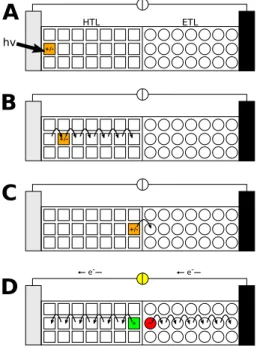
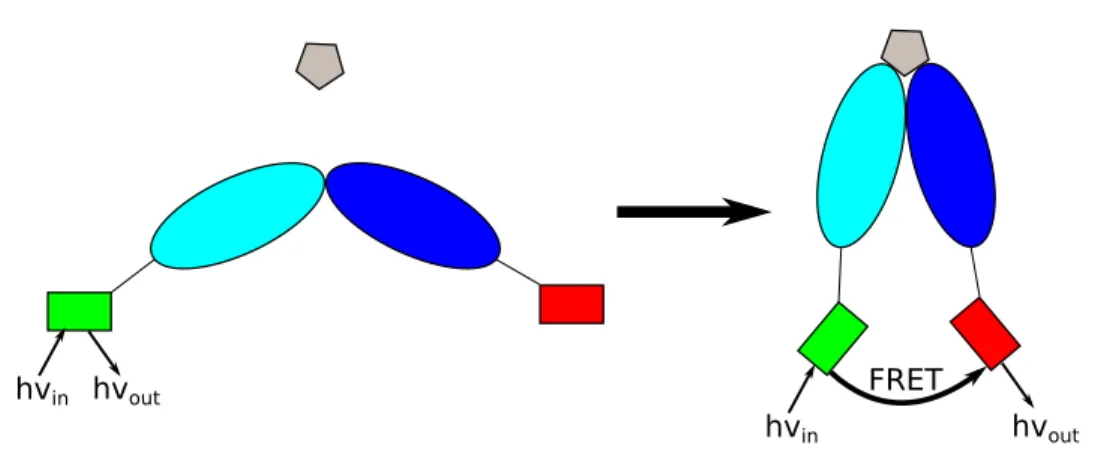
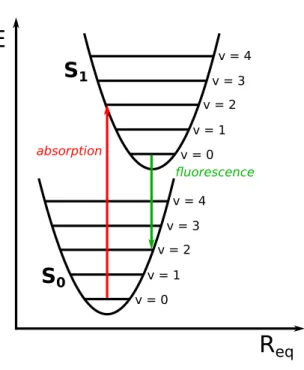
![Table 2.1: Typical time scales of photophysical processes. [11] GS: electronic ground state.](https://thumb-eu.123doks.com/thumbv2/1library_info/4532928.1596393/26.918.263.687.418.583/table-typical-scales-photophysical-processes-electronic-ground-state.webp)
